Basic QC Practices
2025 Great Global QC Survey: Labs Big and Small
In 2025, the Westgard Great Global Survey assessed the state of QC practices. In addition to regional differences, we looked at the differences between high volume and low volume labs. When it comes to QC, does size matter?
The 2025 Global QC Survey Results: Labs big and small
Sten Westgard, MS
October 2025
[This survey was completed with the support and partnership of Thermo Fisher MAS controls.]
In 2025, have QC practices around the world improved or declined?
We surveyed laboratories in 2017 and 2021 about their quality control practices. We did it again in 2025.
We got over 1,280 responses, which break down as follows:
- Africa 118 responses
- Asia 289 responses (note that we include everywhere from India to Australia within this group)
- Europe 143 responses
- Latin and South America 114 responses
- Middle-east 146 responses
- United States and Puerto Rico 440 responses
Asia: 2025 Great Global QC Survey Results: Asia Breakout - Westgard QC
Europe: The 2025 Great Global QC Survey: Europe in isolation - Westgard QC
Middle-East: 2025 Great Global QC Survey Results: Middle East - Westgard QC
Latin and South America: 2025 Great Global QC Survey Results: South and Latin America - Westgard QC
Africa: 2025 Great Global QC Survey Results: Africa - Westgard QC
USA: https://westgard.com/qc-applications/basic-qc-practices/2025-qc-survey-usa.html
All of it together: https://westgard.com/qc-applications/basic-qc-practices/2025-global-qc-survey.html
While we've completed regional analyses, we decided to look deeper at the differences between high volume and low volume laboratories.
- Very high volume laboratories (>5 million tests/year) 126 responses
- Very low volume (<100,000 test/year) 157 responses
We're going to dive right into the differences between the two groups
The QC Set Up
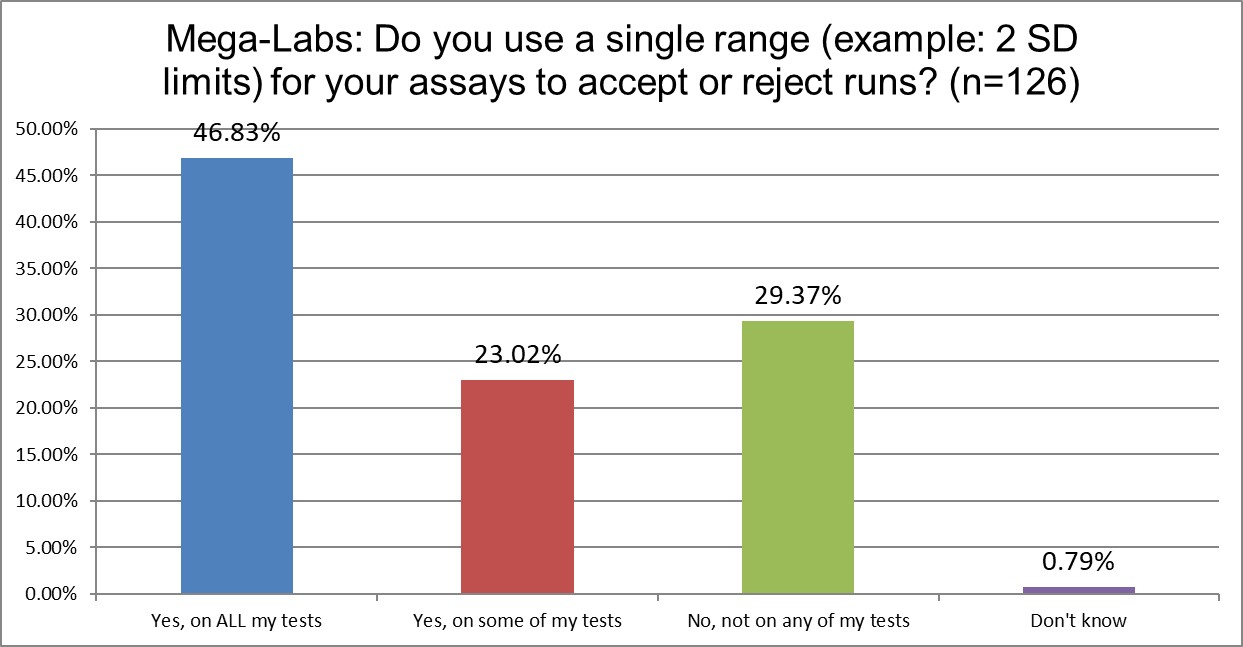
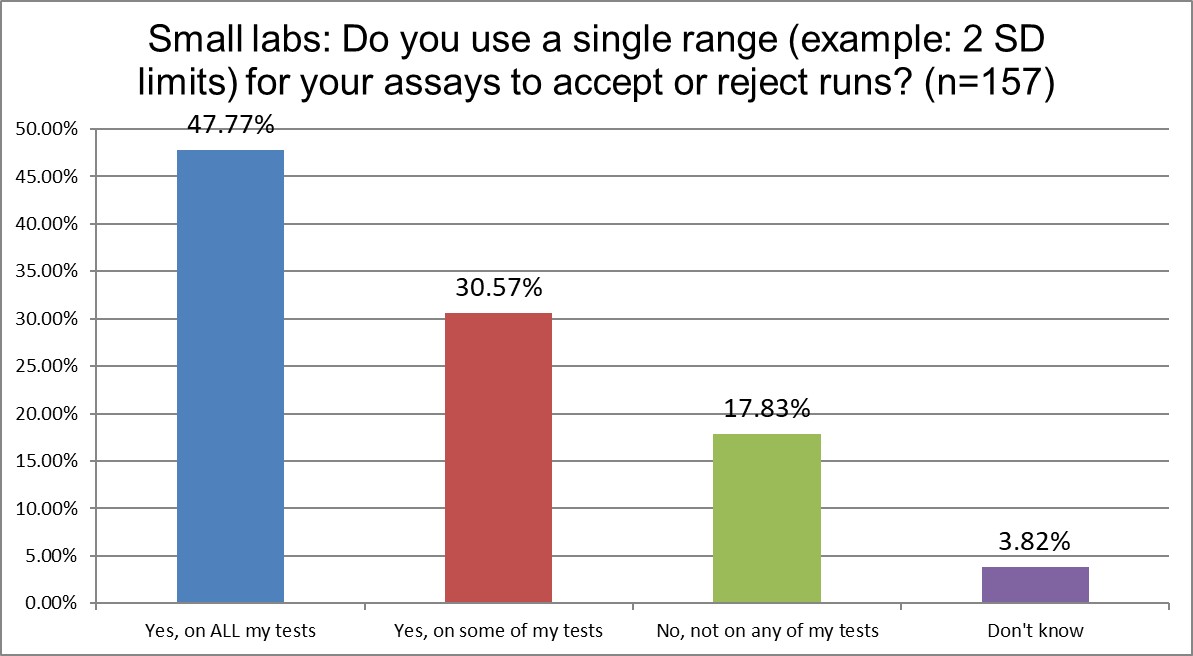
The use of 2 SD on all testing is remarkably consistent across labs both big and small. Almost half of both sizes use 2 SD on all of their tests. The difference occurs in the labs that don't use 2 SD at all. In very large labs, that has reached 29%, versus the almost 18% of small labs that don't use 2 SD. In both cases, however, the "no 2 SD" percentages are larger than the average laboratory.
Warning, Rejection, or Both?
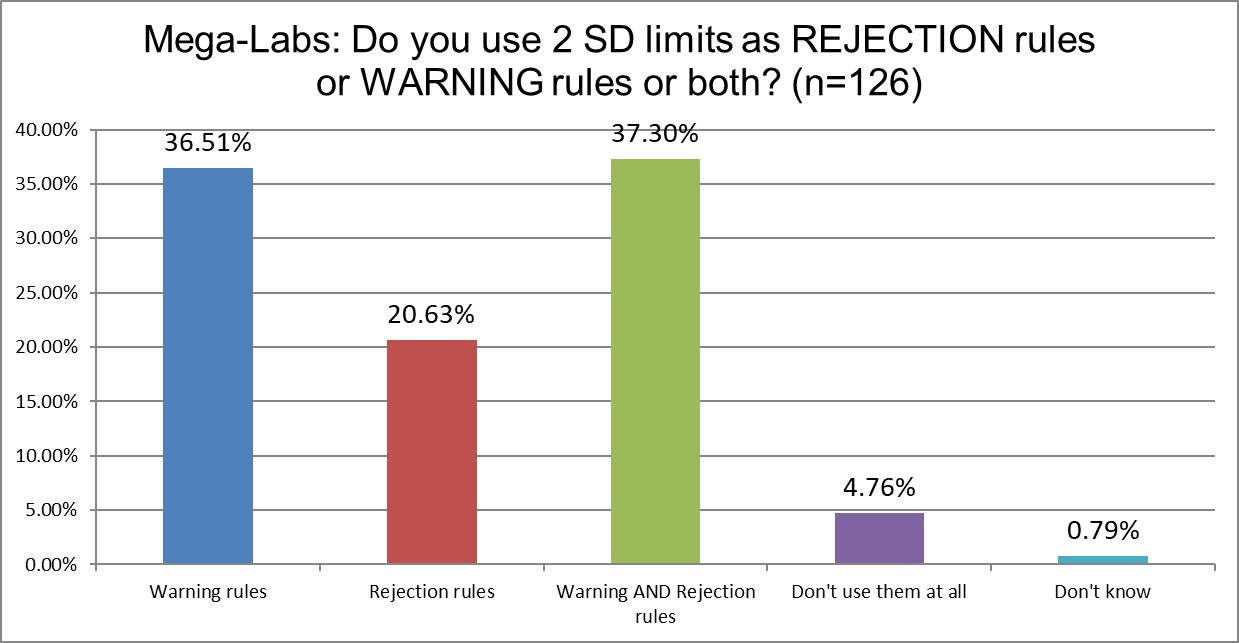
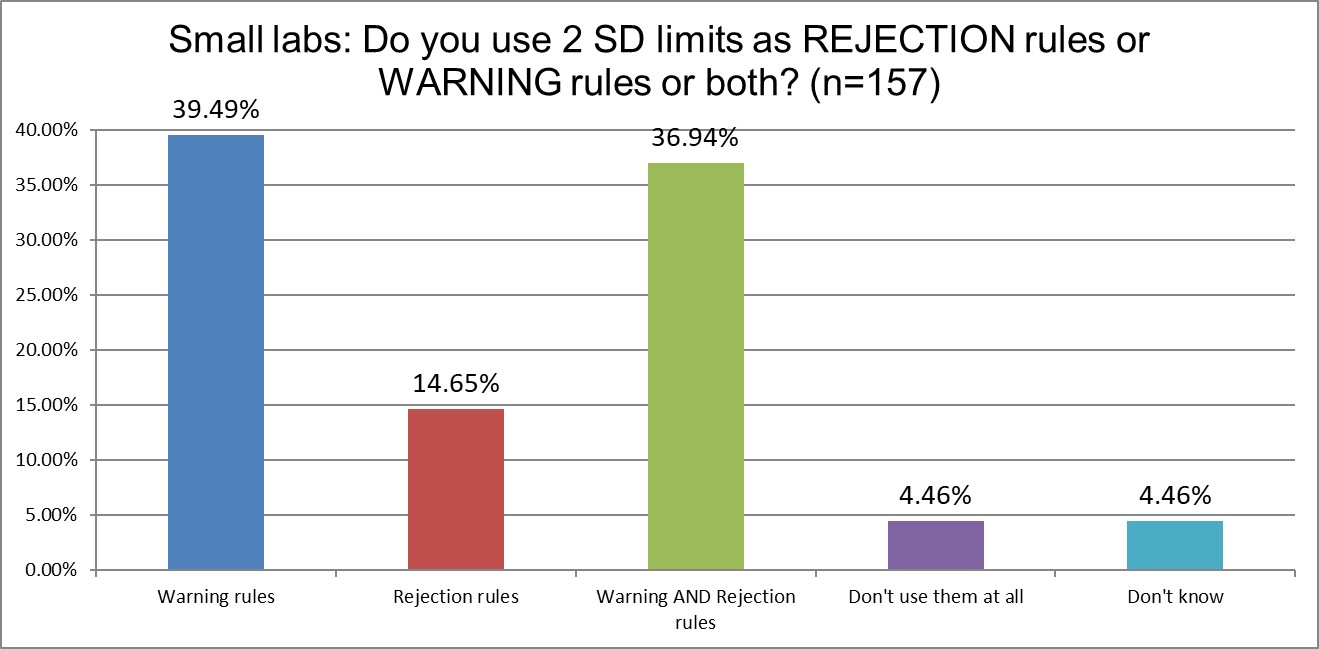
Again, we see marked similarity between the high and low of lab volumes. Almost 40% of labs of either size use the 2 SD as a Warning Rule, and about 37% use it for both warning and rejection. Very large volume labs are more likely to use 2 SD as rejection rules than small labs. Since we know that the 1:2s rule generates a lot of false rejection, this means the very large labs are inflicting more false rejections on themselves than small labs. Bigger, in this case, is not better.
"Westgard Rules" - too wearisome for small labs?
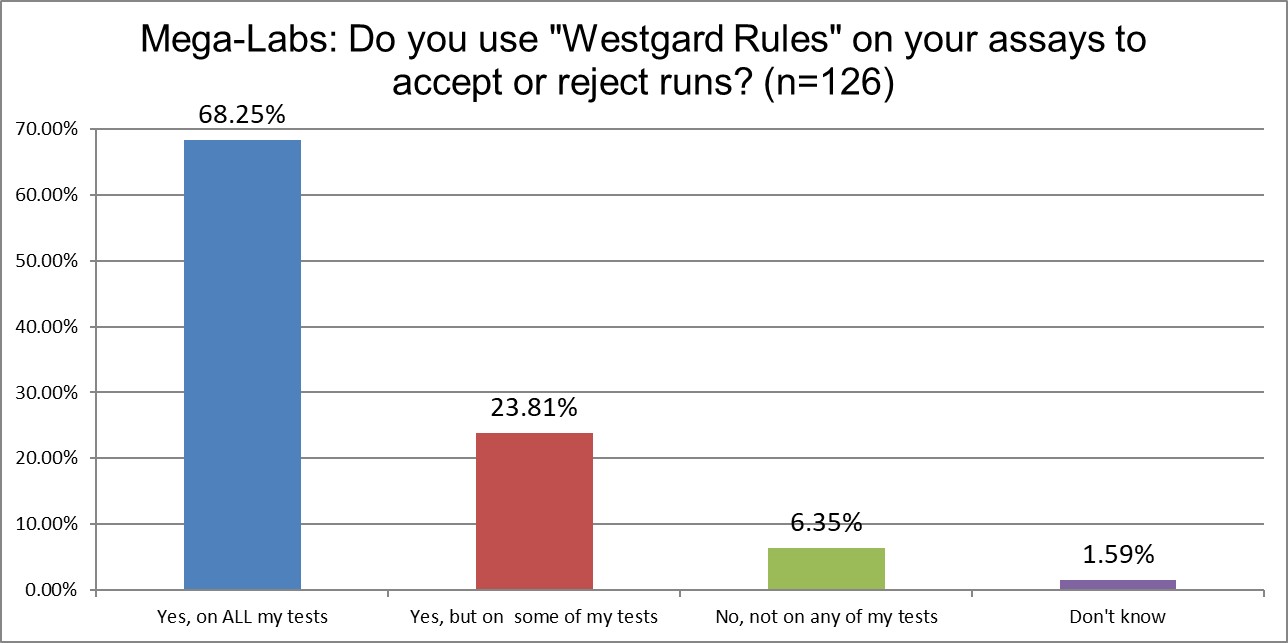
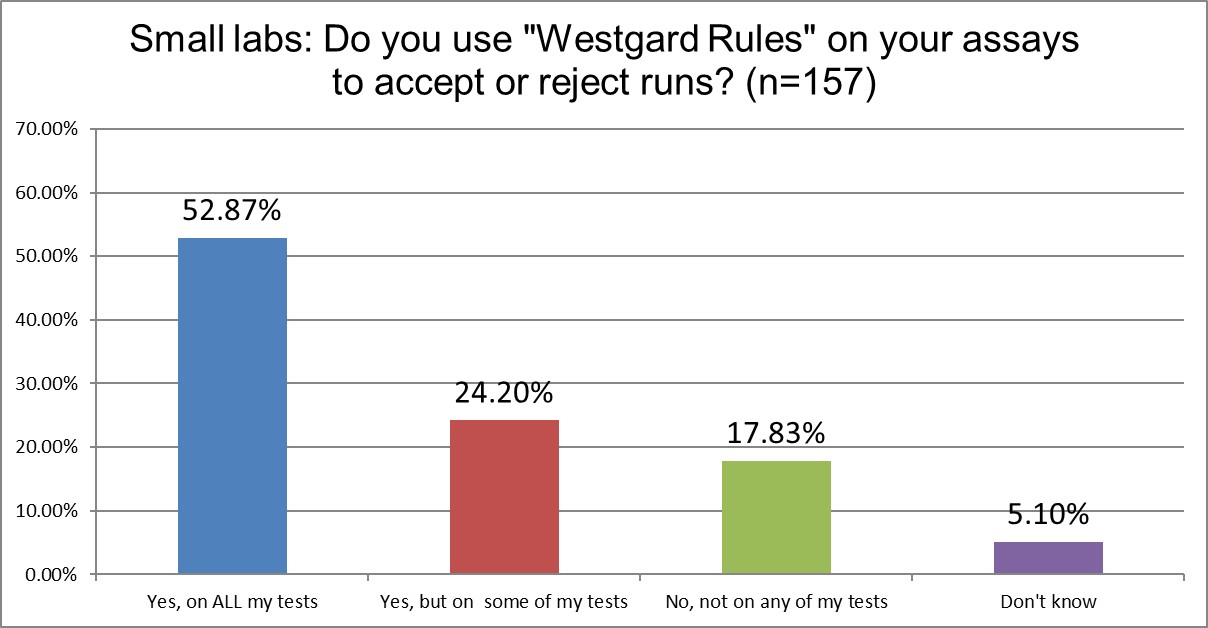
When it comes to "Westgard Rules", we see our first clear significant difference between labs of different sizes. Very large labss are more than 16% more likely to use "Westgard Rules" on all of their tests. About a quarter of each type of labs are using multirules on some of their tests. Small labs are over 11% more likely to use no "Westgard Rules" anywhere in their testing.
Does different volume mean different means?
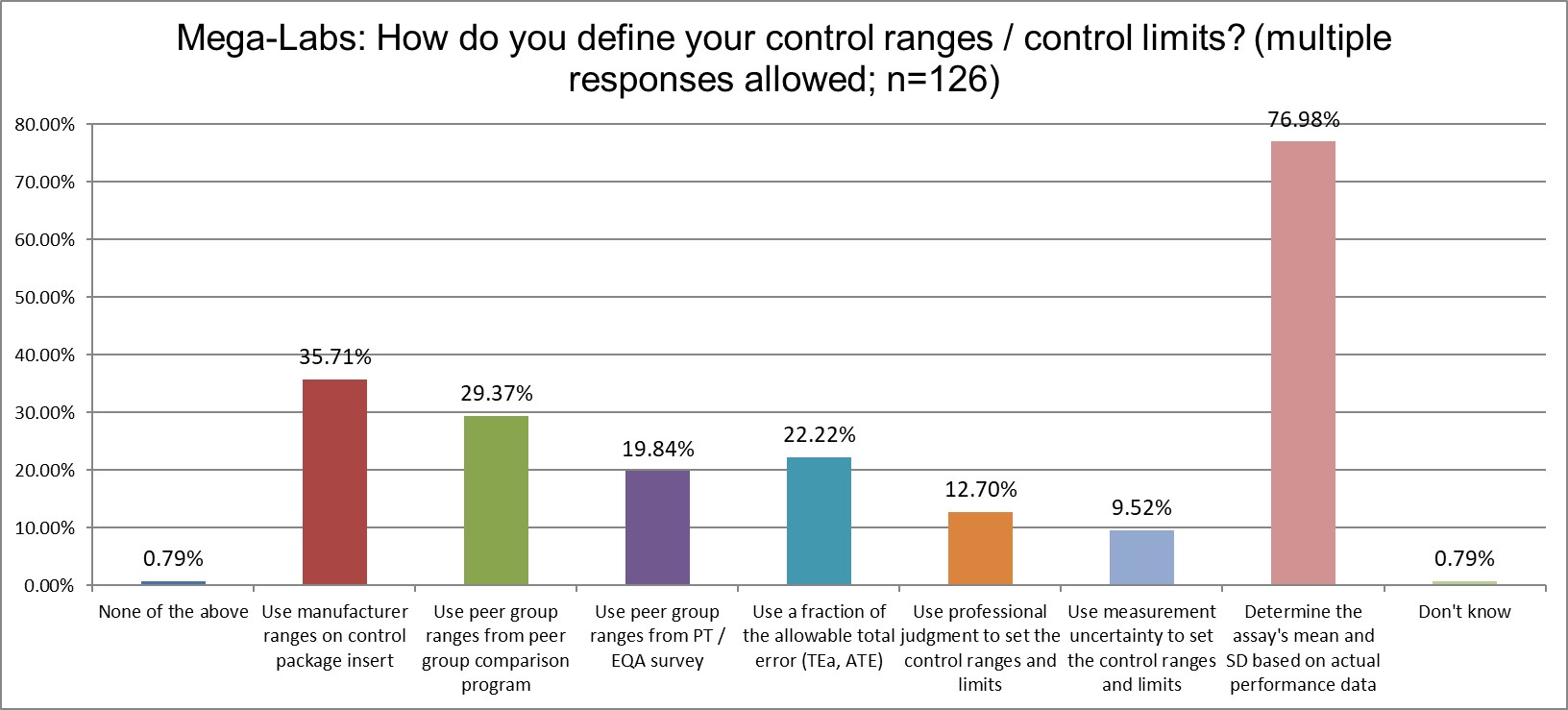
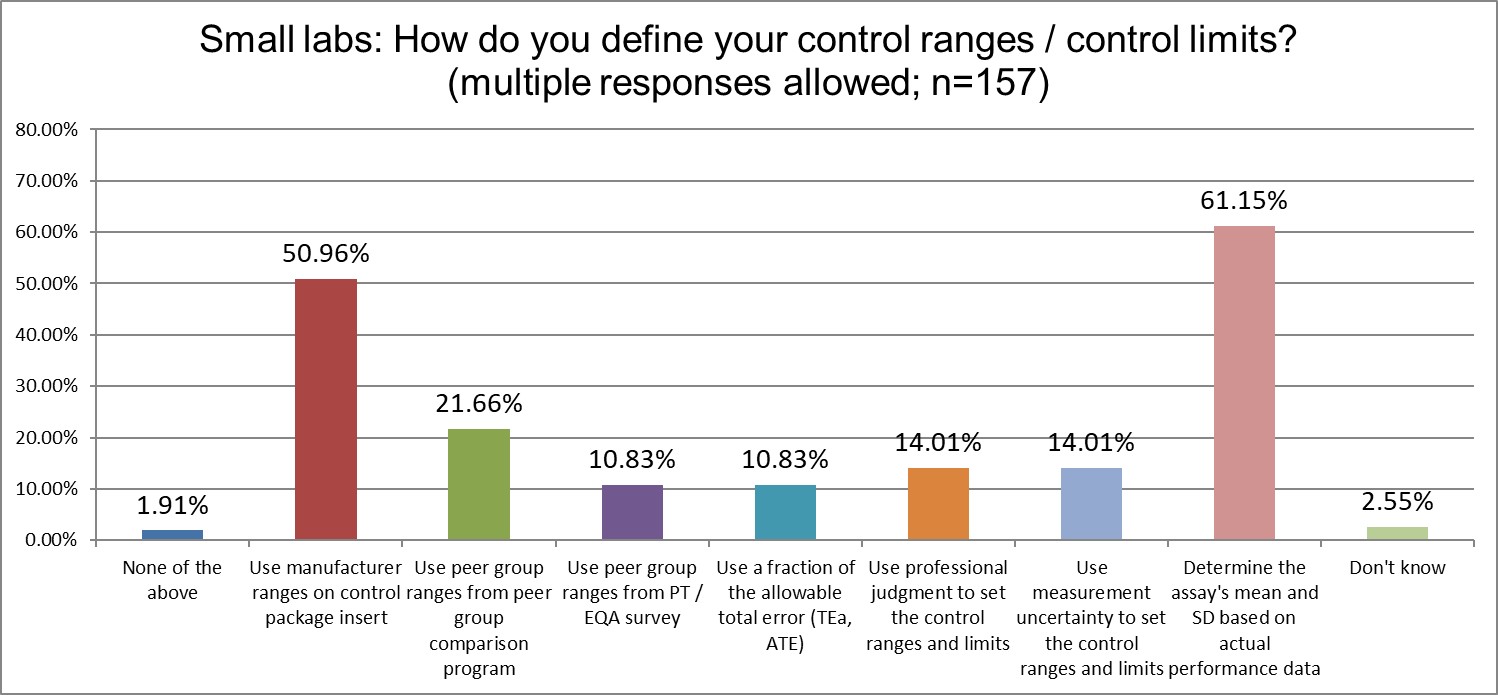
Very large labs lead the world in calculating their own mean and SD, which is both a good thing, and much easier for them to do (they have a lot of data to work with). Nevertheless, a majority of small labs do the same. A bigger difference occurs when it comes to manufacturer ranges. A majority of small labs also use manufacturer ranges, which is 15% more than what occurs in very large labs.
What kind of controls are using in labs big and small?
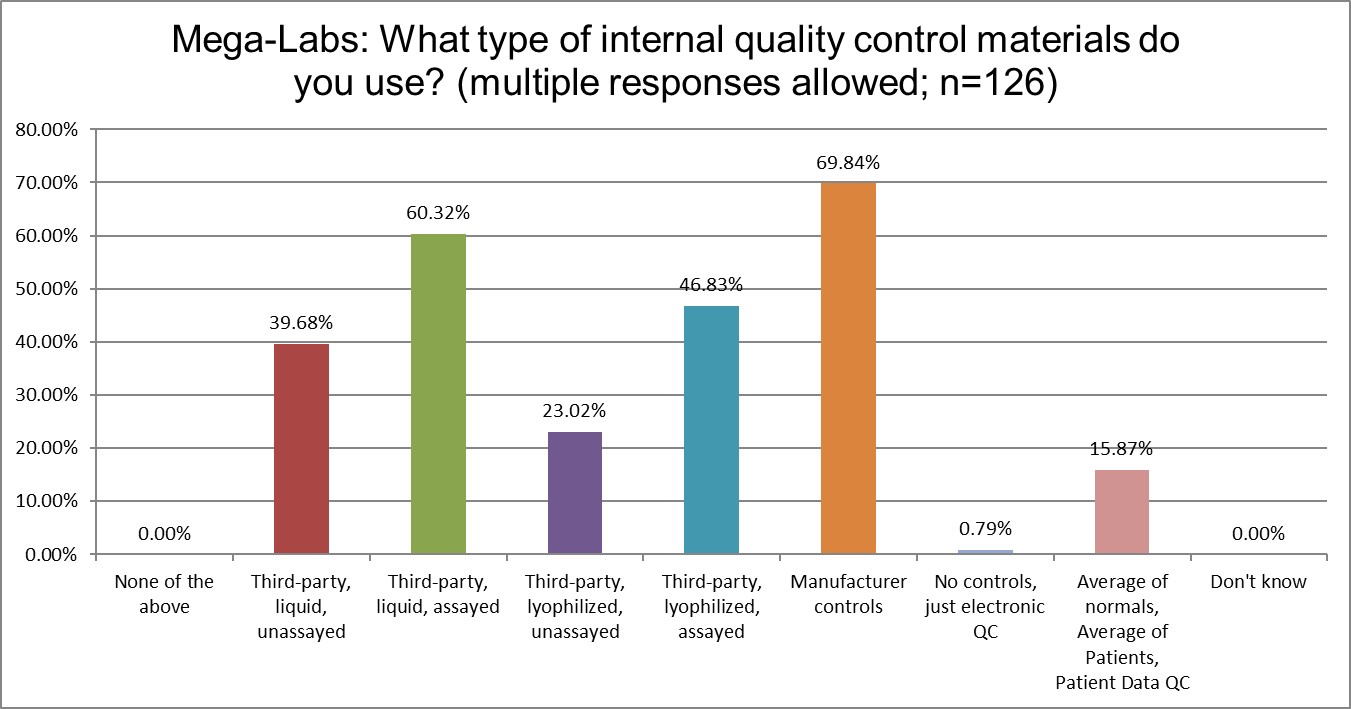
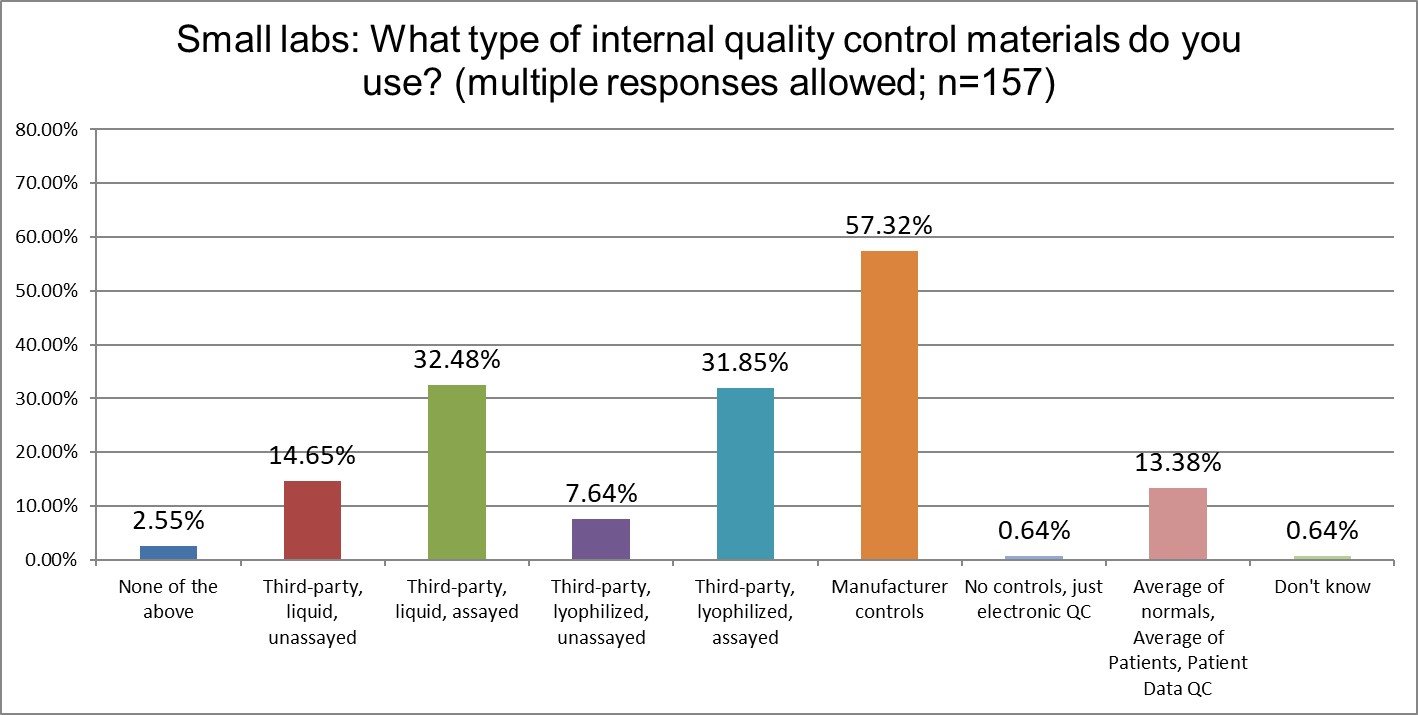
While small labs are more likely to use manufacturer ranges in QC, very larg labs are more like to use manufacturer controls themselves. More than two-thirds of very large labs use manufacturer controls. Small labs are not that far behind, with just over 57%. For both kinds of labs, manufacturer controls are the leading type of controls. Very large labs do make use of other resources, however. A majority of very large labs are using 3rd party liquid assayed controls, while small labs are at nearly half that rate. So even though ISO 15189:2022 has encouraged labs to consider using 3rd party controls, labs are not rushing to adopt them.
One other interesting note: labs both big and small use PBRTQC at about the same rate: 13-15%. You might expect the very large labs to have significantly more use of PBRTQC than small labs, but it's less than a 3% gap. Both kinds of labs use PBRTQC very sparingly.
Just how much QC is patient-based?
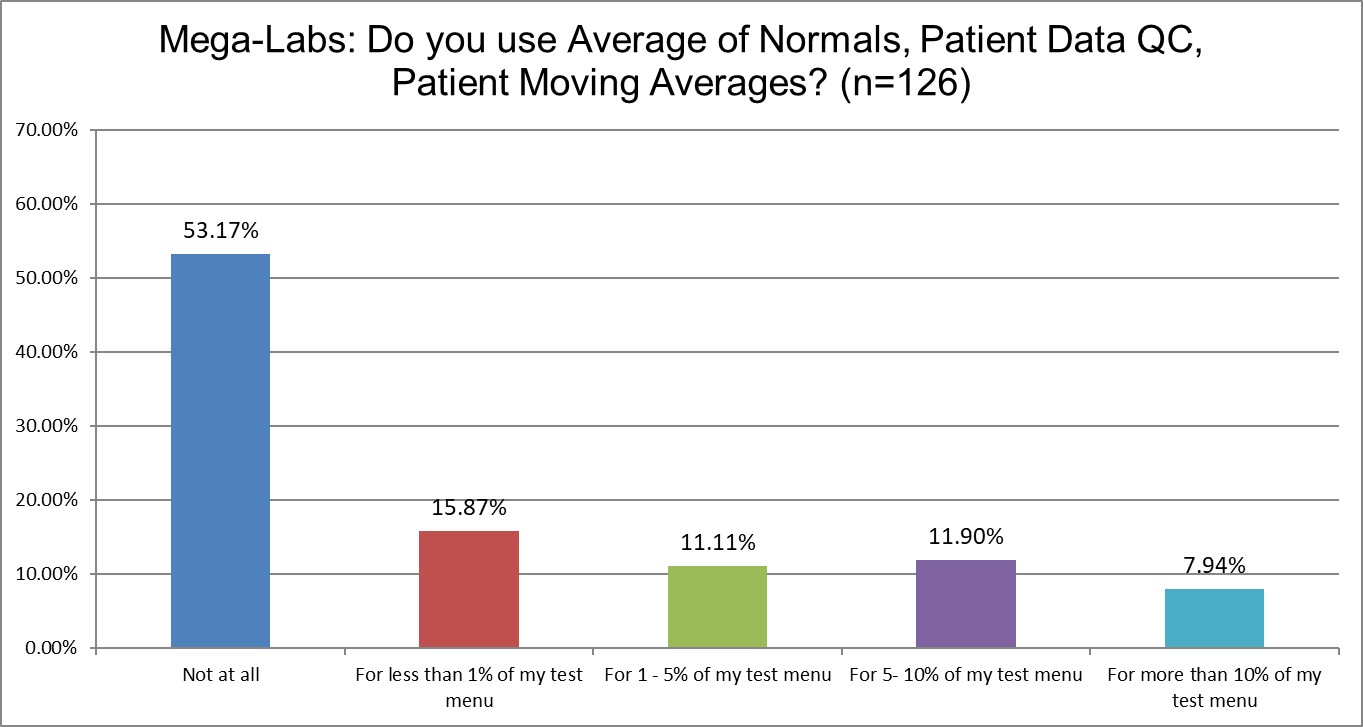
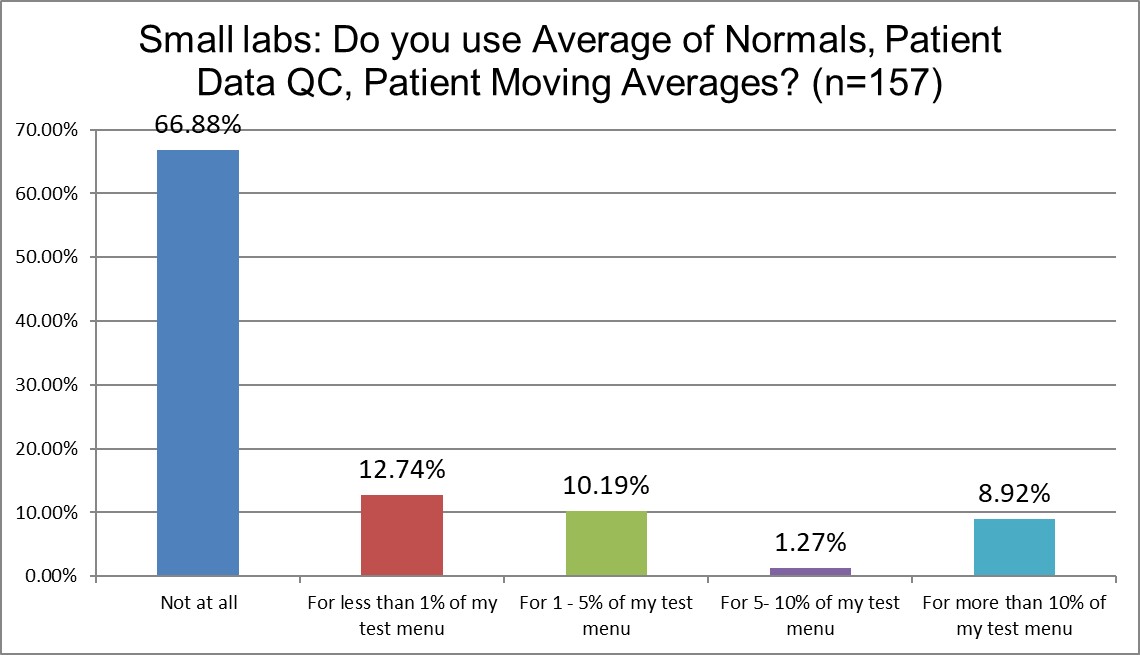
When we probed deeper on the topic of PBRTQC, we did see some differences emerge. Over two-thirds of small labs don't use PBRTQC at all, while that is only a bare majority for very large labs. But, as the previous survey findings showed us, the percentage of labs using PBRTQC for a significant part of their test menu is about the same (around 8-9%) for labs both large and small. In fact, it appears that small labs are more likely to use PBRTQC on more than 10% of their menu than very large labs.
I suppose the expectation is that very large labs have more resources to devote to advanced techniques like PBRTQC, but it appears that their resources are not being spent on this technique. If anything, the very large labs have more reason to use PBRTQC, because they have very high test volume, and if they use only traditional QC techniques, a lot of patient results could be held or need correction when QC is out. PBRTQC would be a useful way to track a high volume of tests (and provide a lot of "free" data for the calculations). Yet that is not what is happening.
PBRTQC remains a bespoke technique, rarely used, and not at a scale where it can provide robust solutions to laboratory QC challenges.
The Real Practice of Running Controls
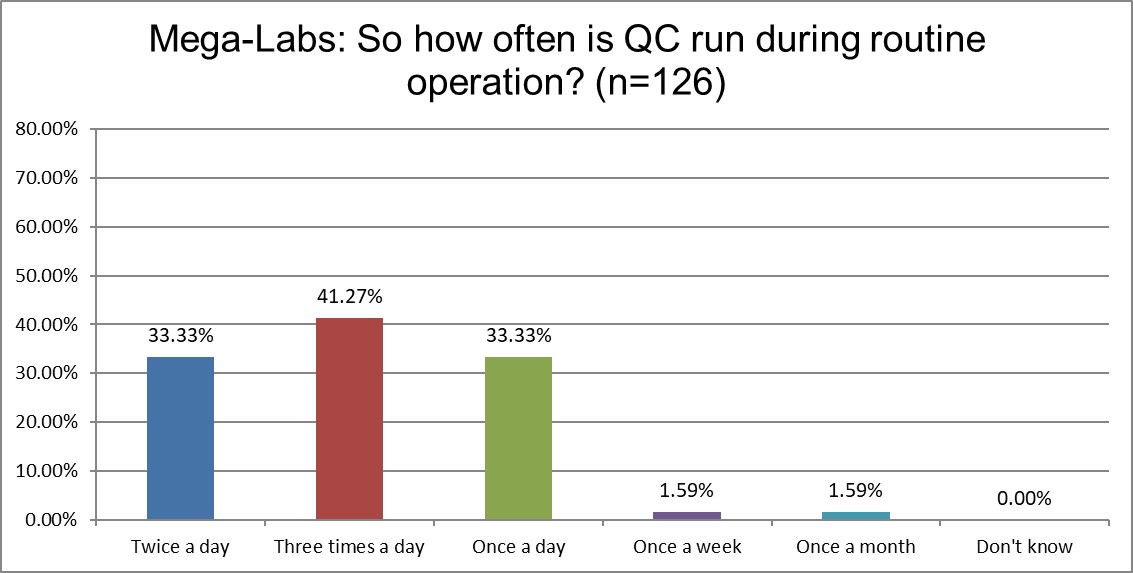
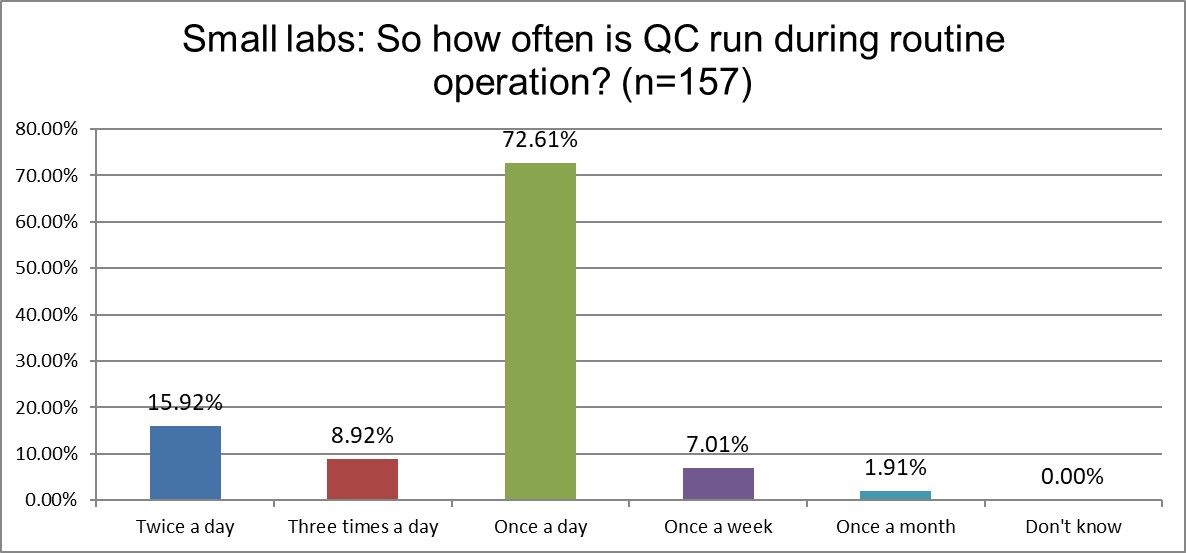
Running three times a day QC in Africa held steady at around 11%, one of the lowest rates in the world. Running QC once a day significantly increased from 48% up to 60.7%. Running QC 2x a day decreased from 37% in 2021 to 28% in 2025. In summary, less QC is being run by labs in Africa, at least the rate of running QC.
Who has more trouble? Big labs or small?
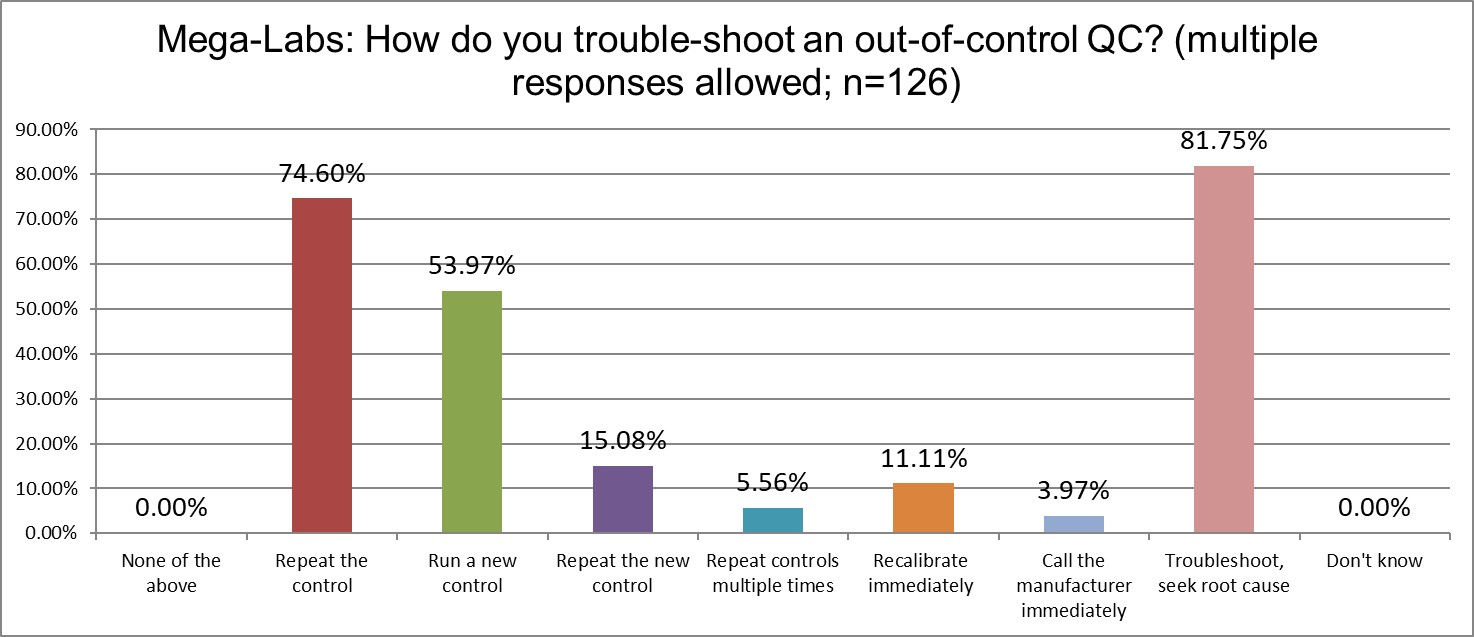
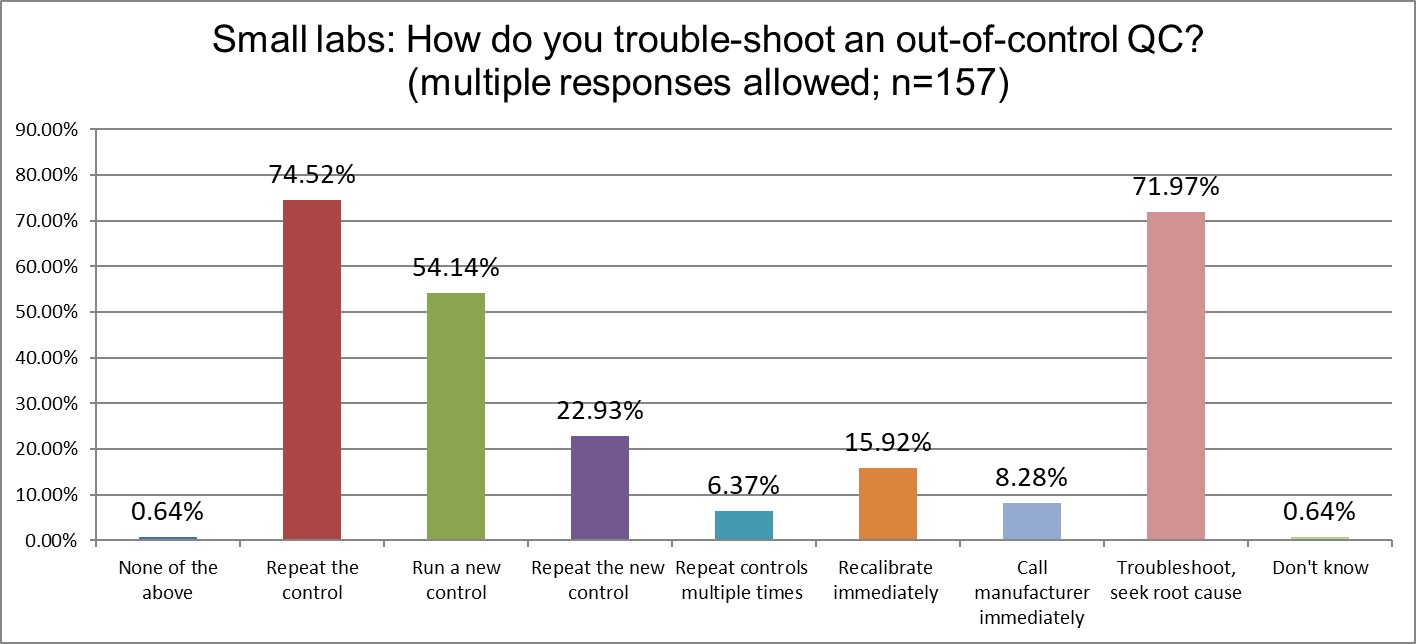
Another suprising consistency! 75% of labs both big and small repeat the control in response to an outlier. Even running a new control is nearly identical, about 54% of labs big and small do it. Small labs are more likely to repeat the new control, however, so there is one difference. Small labs are also slightly more likely to keeping repeating and repeating, to recalibrate immediately after an outlier, and to call and complain to the manufacturer immediately. Very large labs are about 10% more likely than small labs to troubleshoot thoroughly.
Who's out of control more often? Big labs or small?
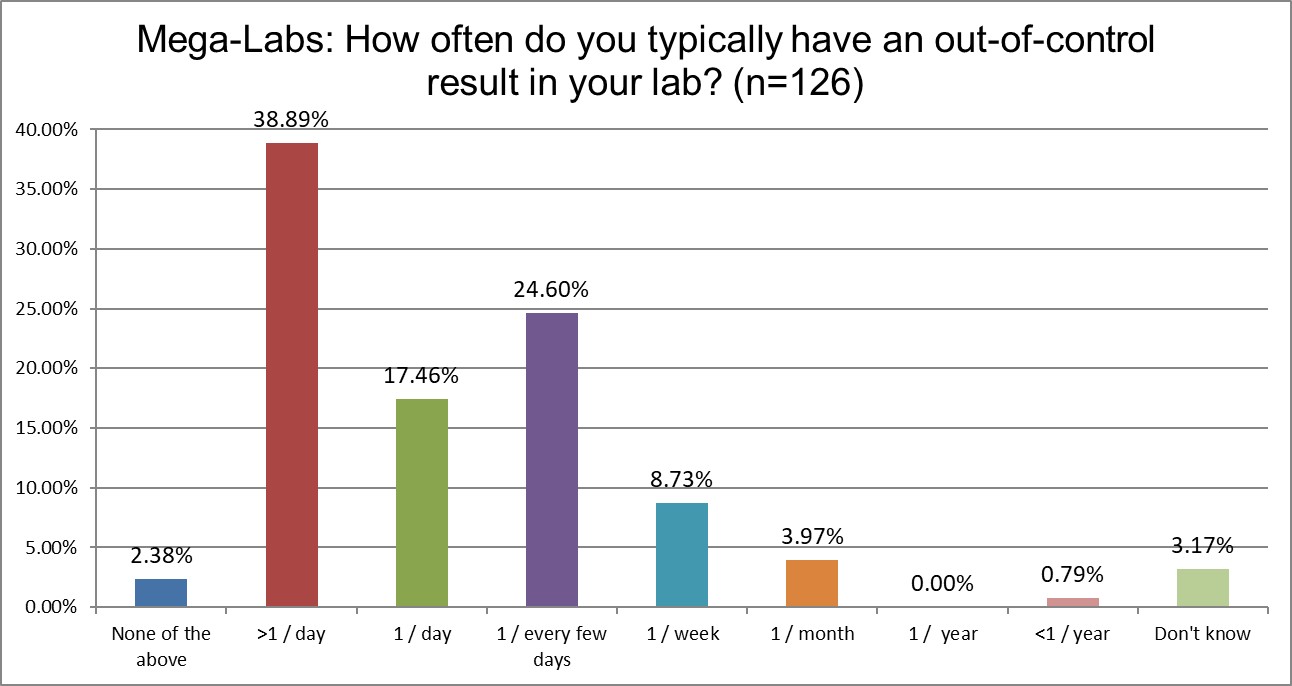
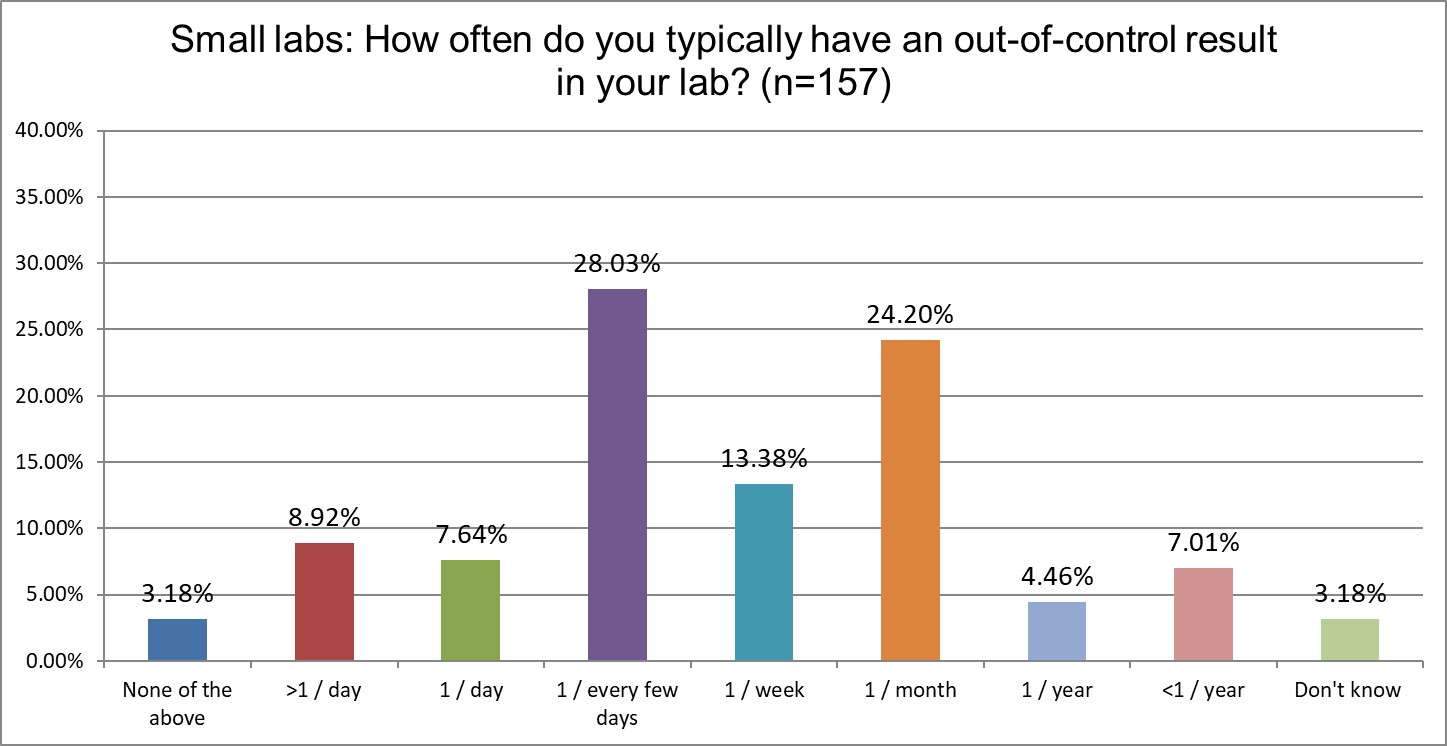
Here is the biggest difference between very large labs and small labs. The very large labs are 400% more likely to be out-of-control more than once a day. A majority of very large labs (>56%) are out of control every day, if not multiple times per day. In contrast, only 16% of small are out-of-control every day. Are very large labs just 4X worse at quality than their small lab counterparts? In order to seek out lab testing that has fewer out-of-control events, should we de-centralize our laboratory operations?
Of course not, this is just more evidence that poor QC choices and subsequent false rejection are the real source of outliers. Larger volume labs run more tests, so they have more false rejections. They're out of control more often not because there are really more quality problems, it's just a numbers game. Bigger menu with bad QC choices means more false rejections. Very large labs aren't having more quality problems with their methods, just more false alarms from their QC.
How do labs re-test?
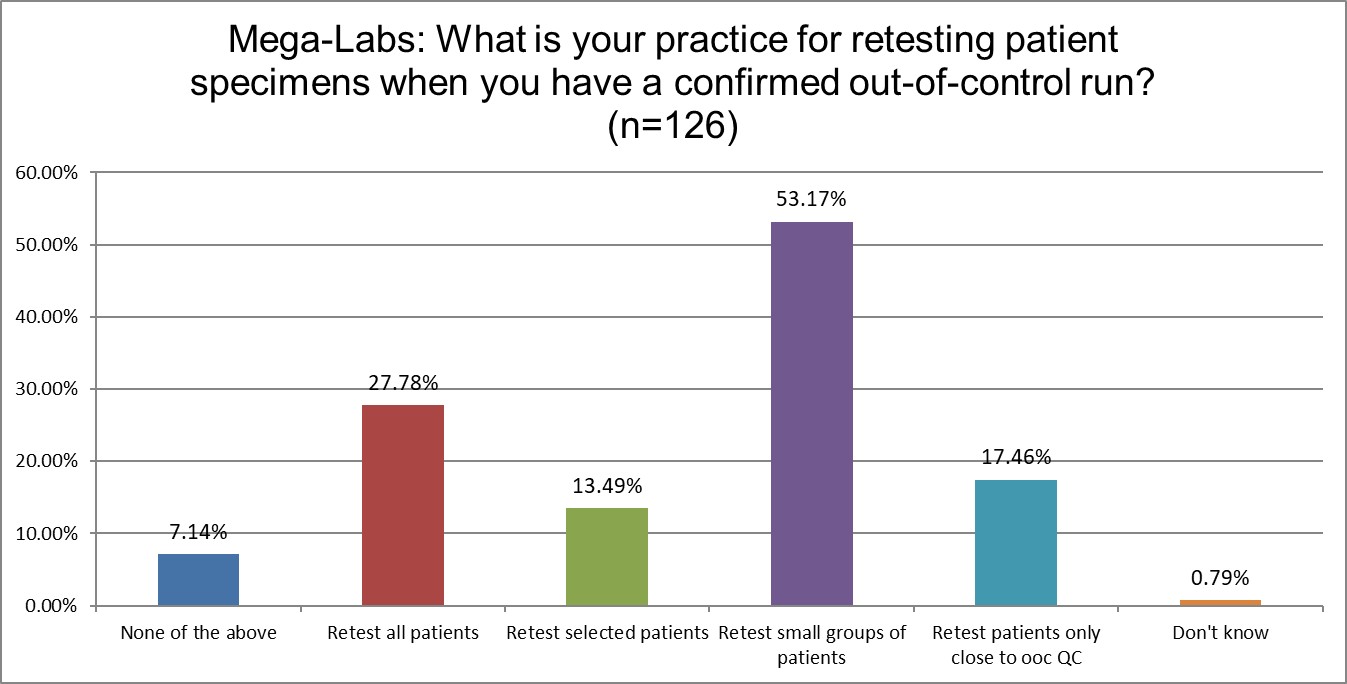
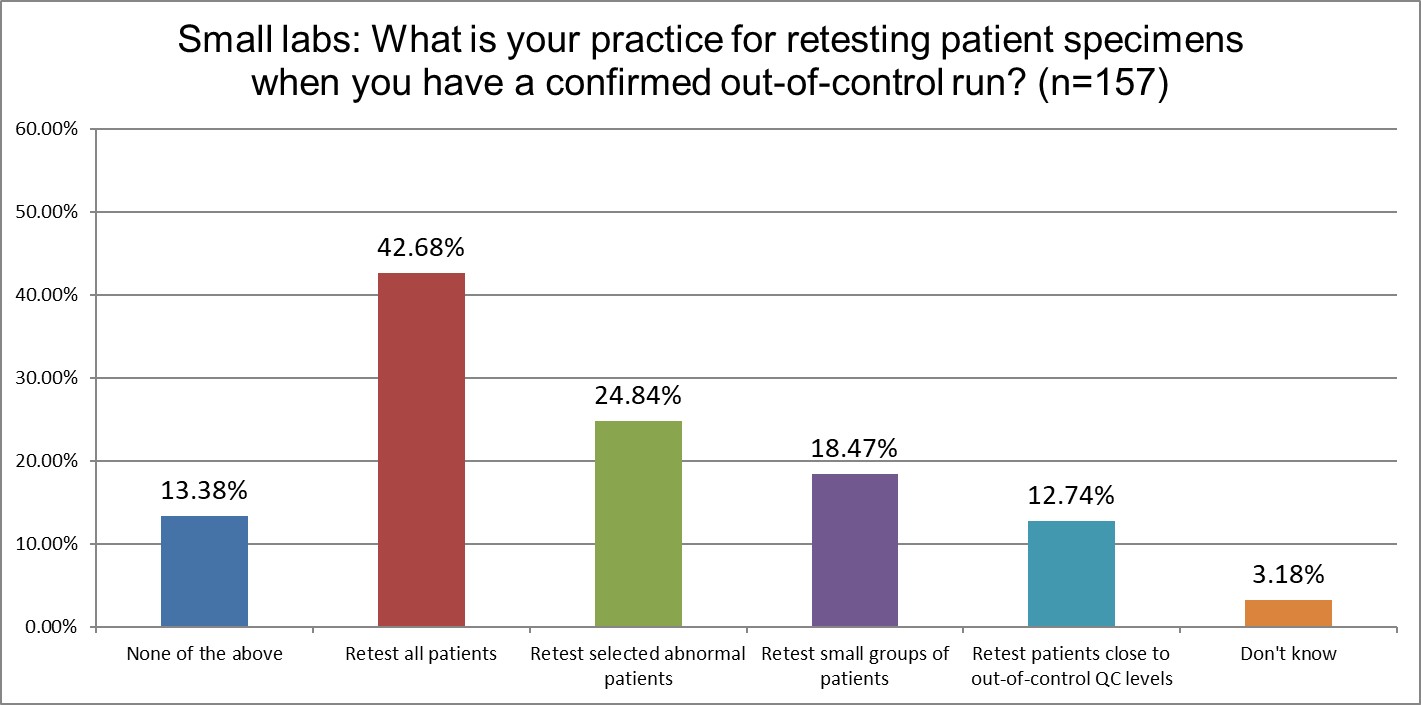
Again we see a marked difference between labs very large and small. Probably because it's easier, more than 40% of small labs simply retest all patient samples when the run is out-of-control. As lab professionals know, the mega-labs probably don't have capacity to repeat all of their patient samples, so a majority of them retest only small groups of patients instead.
How likely are labs of different sizes to override their own QC?
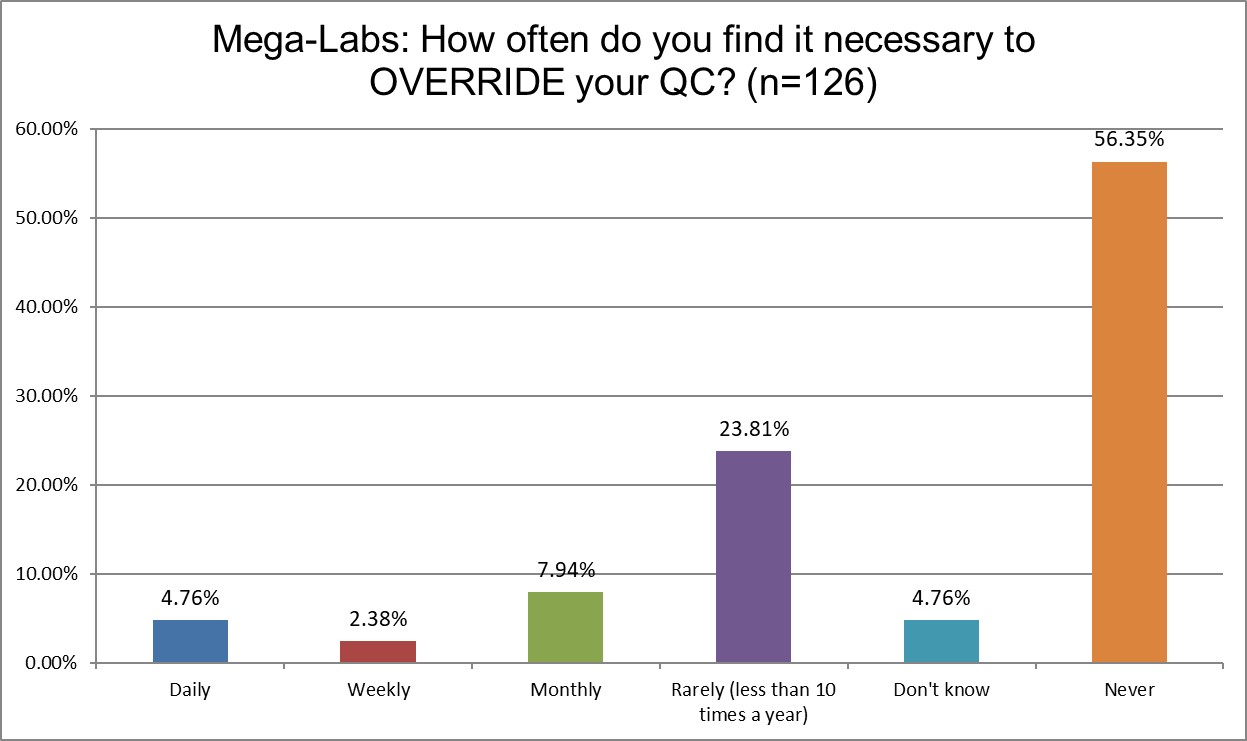
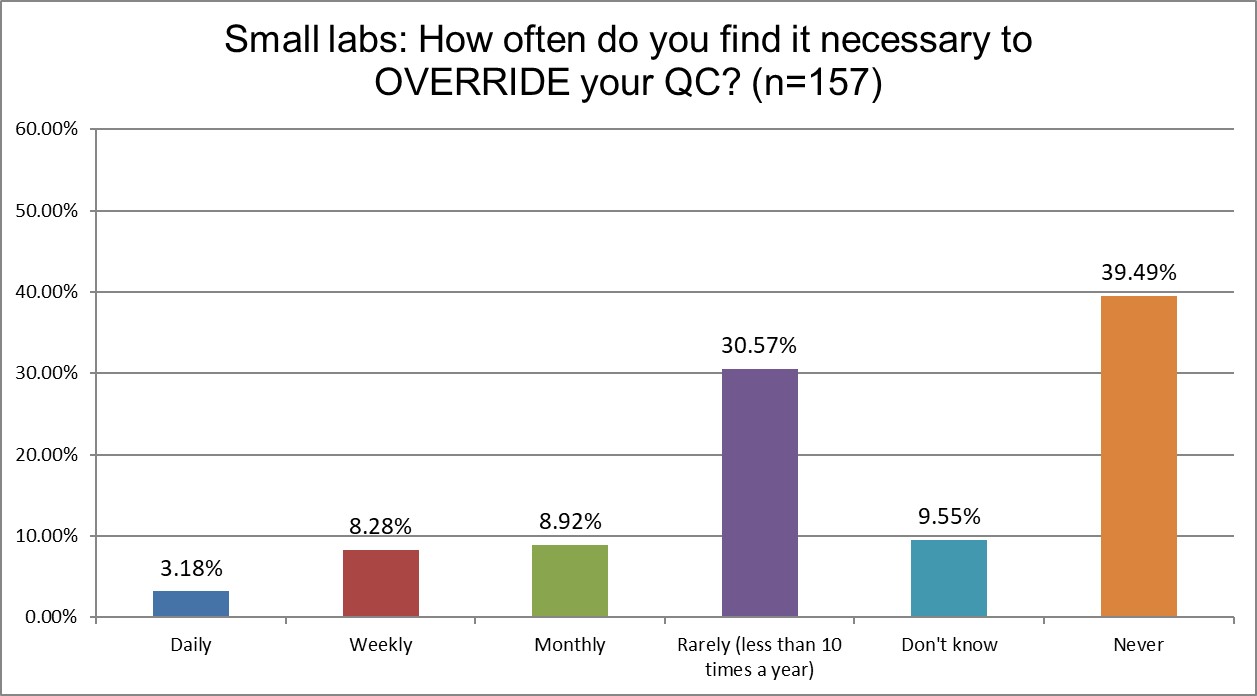
The good news is that the number of labs that send out test results even when there's an out of control run is small. Very large labs are less likely to do this than small labs. 20% of small labs will override their QC on a regular basis (daily, weekly or monthly). A little over 15% of very large labs are in the same position. Given the QC issues we've seen earlier in the survey responses, it's not surprising that labs big and small don't trust their own QC flags (because their laden with self-induced false rejections). Nevertheless, it's a dangerous practice, to release results to clinicians even when the QC is out.
Which labs include the uncertainty of bias correction in their measurement uncertainty calculations?
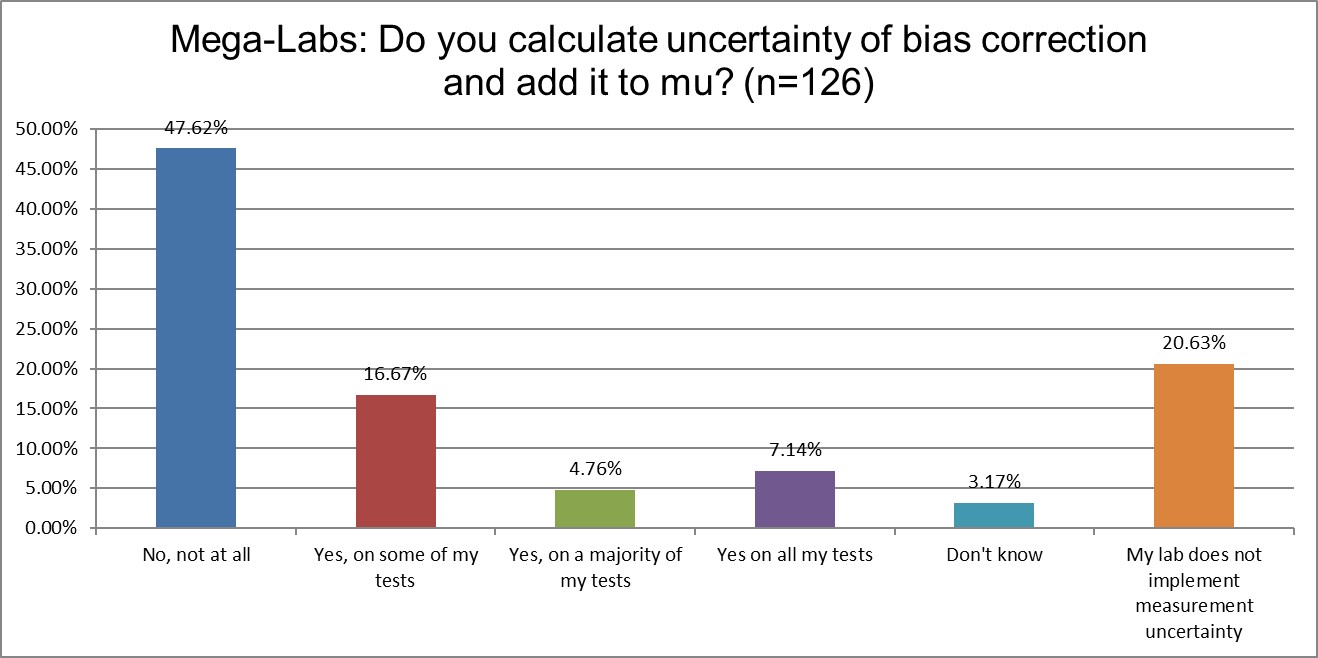
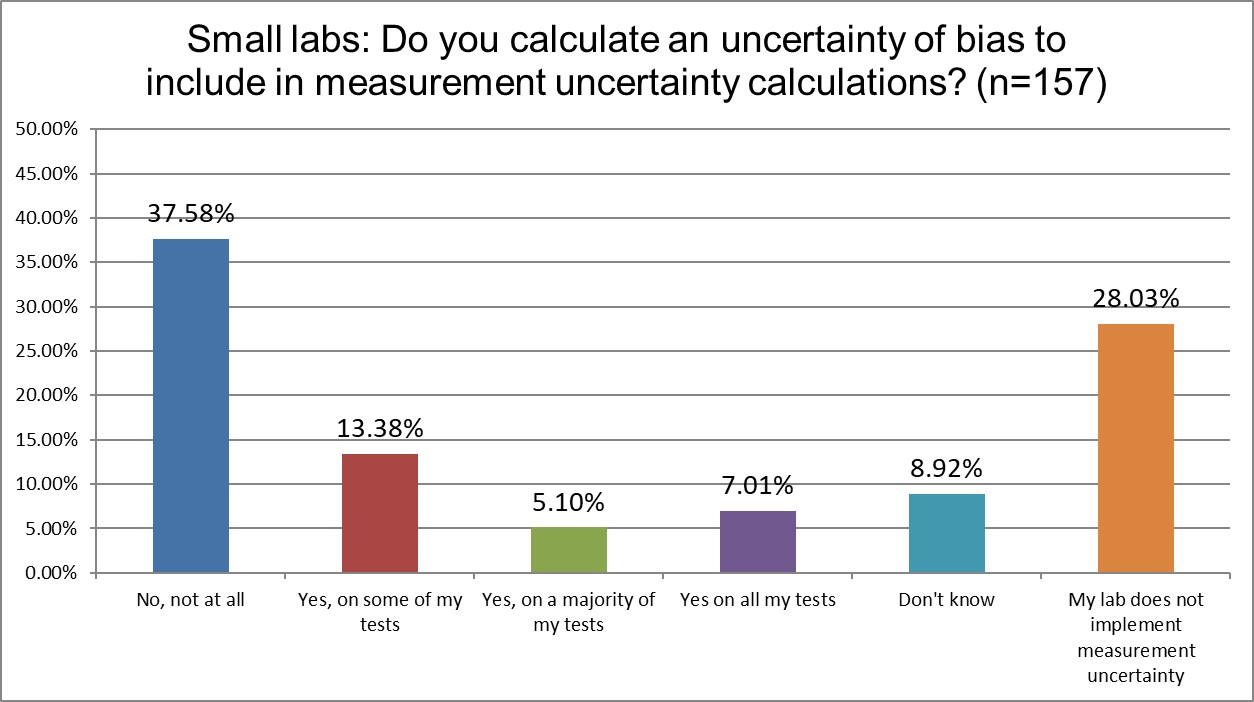
Interestingly, it appears that very large labs calculate the uncertainty of bias correction less than small labs do. Now, only 20% of very large labs state that they don't calculate mu at all, contrasted to 28% of small labs. That implies a very large number of labs of both sizes are calculating mu. It's just that very few of them are including bias in their mu calculations.
The Final Overview
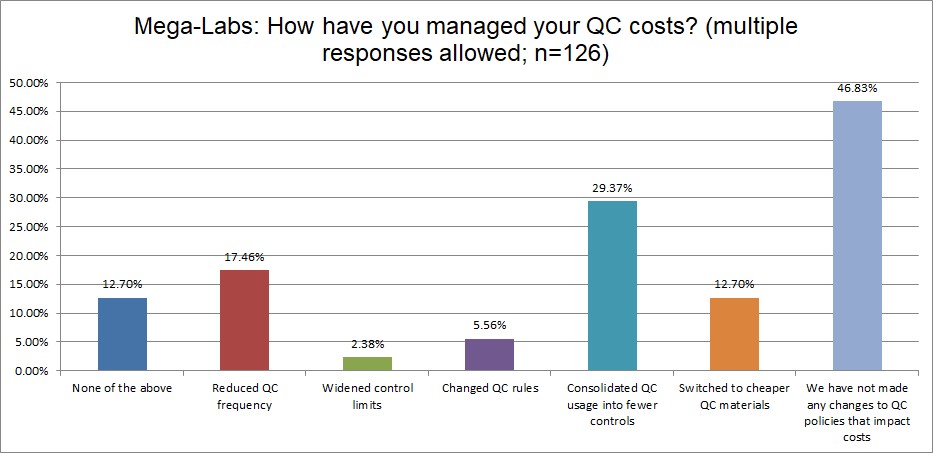
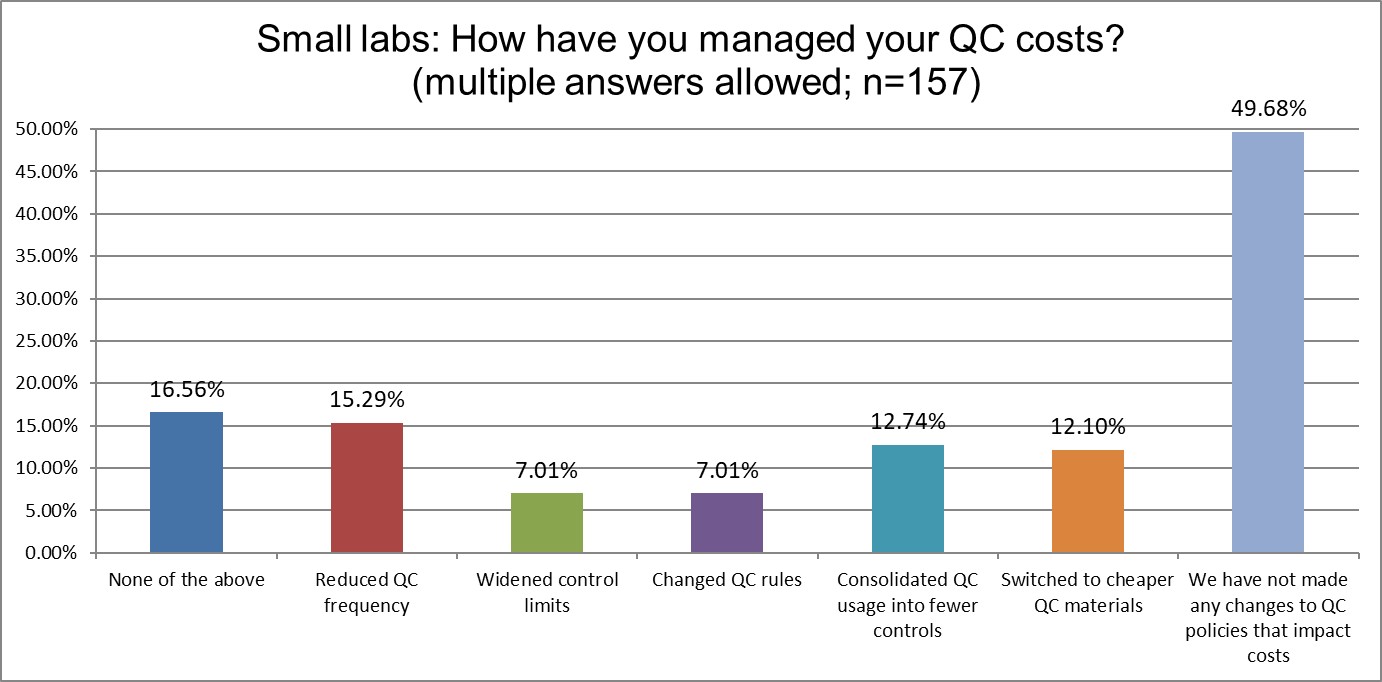
One more interesting similarity: the same proportion of labs large and small have done nothing to manage their QC costs (about 47 to 50%). Deeper in the details, there is one significant difference in other actions. Almost 30% of very large labs have performed some kind of QC consolidation, while only about 13% of small labs have done so. For both labs, only about 12% have switched to cheaper controls. And labs both large and small have done little in the way of changing their QC rules (5.6% vs 7%), even though this simple approach might alleviate their huge burden of false rejections.
Conclusion
Labs both large and small experience a lot of the same pain. Both practice poor QC habits, causing a lot of self-inflicted harm. There are easy remedies available, there for the taking, regardless of the volume of your laboratory.

